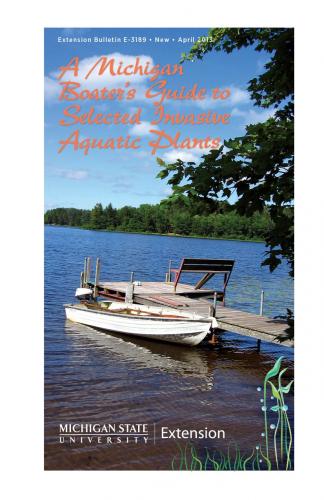Michigan Boater’s Guide provides on-board help with invasive aquatic plant identification
Hot off the press and into the boat! New aquatic invasive species guide from MSU Extension helps ID plants and provides direction on what to do when you find one.
 Michigan State University Extension has recently published A Michigan Boater’s Guide to Selected Invasive Aquatic Plants. This handbook is printed on water-repellent paper and is small enough to keep stored onboard in the event a suspicious plant is located while recreating on a Michigan waterway. It includes full-color photos and range maps for selected invasive aquatic plants and a glossary of plant terminology.
Michigan State University Extension has recently published A Michigan Boater’s Guide to Selected Invasive Aquatic Plants. This handbook is printed on water-repellent paper and is small enough to keep stored onboard in the event a suspicious plant is located while recreating on a Michigan waterway. It includes full-color photos and range maps for selected invasive aquatic plants and a glossary of plant terminology.
Invasive species have been identified as major biological pollutants. They are species that enter an ecosystem from beyond their natural range and establish reproducing populations. They can cause significant environmental, socio-economic, and public health damage to their new environment. Because they are freed from natural predators, pathogens, and competitors that would normally keep their numbers in check, invasive species have a competitive advantage over native species and often out-compete them for space and food.
Their invasive tendency can result in major habitat change, degradation and loss of biological diversity. Their presence can result in millions of dollars of expenditures in efforts to control their populations. Within the Great Lakes alone, more than 136 species of plants and animals are established. Many of these plants produce numerous seeds and/or reproduce through fragmentation, making them difficult to control and manage.
The Boater’s Guide features 11 invasive plants that either currently pose a threat to the ecosystem or are prone to if they become established. Others are not yet listed but have been found in neighboring states and are considered threats to Michigan waterways.
An important feature of the new Boater’s Guide is its connection to the Midwest Invasive Species Information Network (MISIN). The MISIN website is Michigan’s designated repository for invasive plant and animal sightings. This interactive mapping and rapid response website allows anyone to enter site-specific locations or upload photos. It also provides additional assistance with identification.
For smartphone users, each plant page of the new guide contains a QR code that, when scanned, takes the user directly to the MISIN website for more information about that particular plant. The guide also provides information about MISIN’s smartphone app -- available for free download on the MISIN website.
By reporting your findings, you contribute to a multi-state database on invasive species. As a boater or any concerned citizen, your help in reporting sightings of invasive species is important. The guide also reminds boaters to remove all plant material from their boat and trailer before leaving the ramp.
MSU Extension publication E3189, A Michigan Boater’s Guide to Selected Invasive Aquatic Plants, is available through the MSU Extension Bookstore. Cost is $10 per copy with reduced prices for bulk orders.



 Print
Print Email
Email




